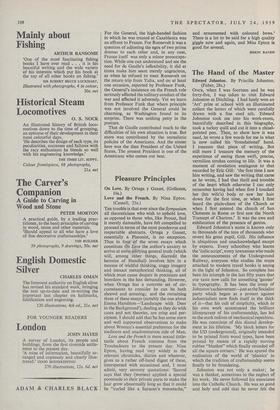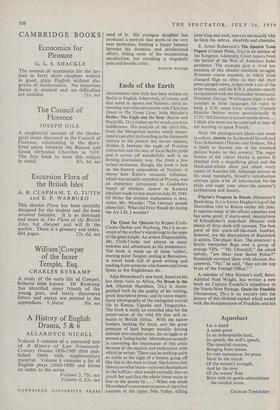The Hand of the Master
ONCE, when I was fourteen and he was forty-five, I wap taken to visit Edward Johnston at Ditchling. I had lately won an 'Art' prize at school with an illuminated collect the letters of which were carefully drawn with a fine steel nib. Edward Johnston took me into his work-room, beautifully described in this biography, took a turkey quill and cut it into a chisel- pointed pen. Then, to show how it was used, he wrote a few words for me in what is now called his 'foundational' hand. I treasure that piece of writing. But still more I treasure the memory of the experience of seeing those swift, precise, vermilion strokes coming to life. It was a moment of revelation analagous to that recorded by Eric Gill: 'the first time I saw him writing, and saw the writing that came as he wrote, I had that thrill and tremble of the heart which otherwise I can only remember having had when first I touched her (his wife's) body or saw her hair down for the first time, or when I first heard the plain-chant of the Church or when I first entered the church of San Clemente in Rome or first saw the North Transept of Chartres.' It was the awe and exhilaration of the presence of genius.
Edward Johnston's name is known only to thousands of the tens of thousands who revere his great pupil, Gill. His influence is ubiquitous and unacknowledged except by experts. Every schoolboy who learns the 'italic script', every townsman who reads the announcements of the Underground Railway, everyone who studies the maps attached to modern travel books is seeing in the light of Johnston. So complete has been his triumph in the last fifty years that our taste now calls for something 'gamier' in typography. It has been the irony of Johnston's achievement—just as the Socialist party which began as a protest against industrialism now finds itself in the thick of it—that his cult of simplicity, which in his own work accentuated the brilliant idiosyncrasy of his craftsmanship, has led to the stark tedium of mechanical repetition. He was conscious of this dismal develop- ment in his lifetime. 'My block letters for the UD (underground), originally intended to be printed from wood types, have been printed by means of a rapidly moving rubber "blanket" which finally rounded off all the square corners.' He was spared the realisation of the world of 'plastics' in which the tradition of craftsmanship seems finally to be foundering.
Johnston was not only a maker; he was a thinker, sometimes to the neglect of his work. He never followed his associates into the Catholic Church. He was so good and holy and odd that he never felt the
need of it. His youngest daughter has produced a portrait that seems to me very near perfection, keeping a happy balance between his domestic and professional affairs, hiding none of his exasperating peculiarities, but revealing a singularly pure and lovable artist.
EVELYN WAUGH







































 Previous page
Previous page